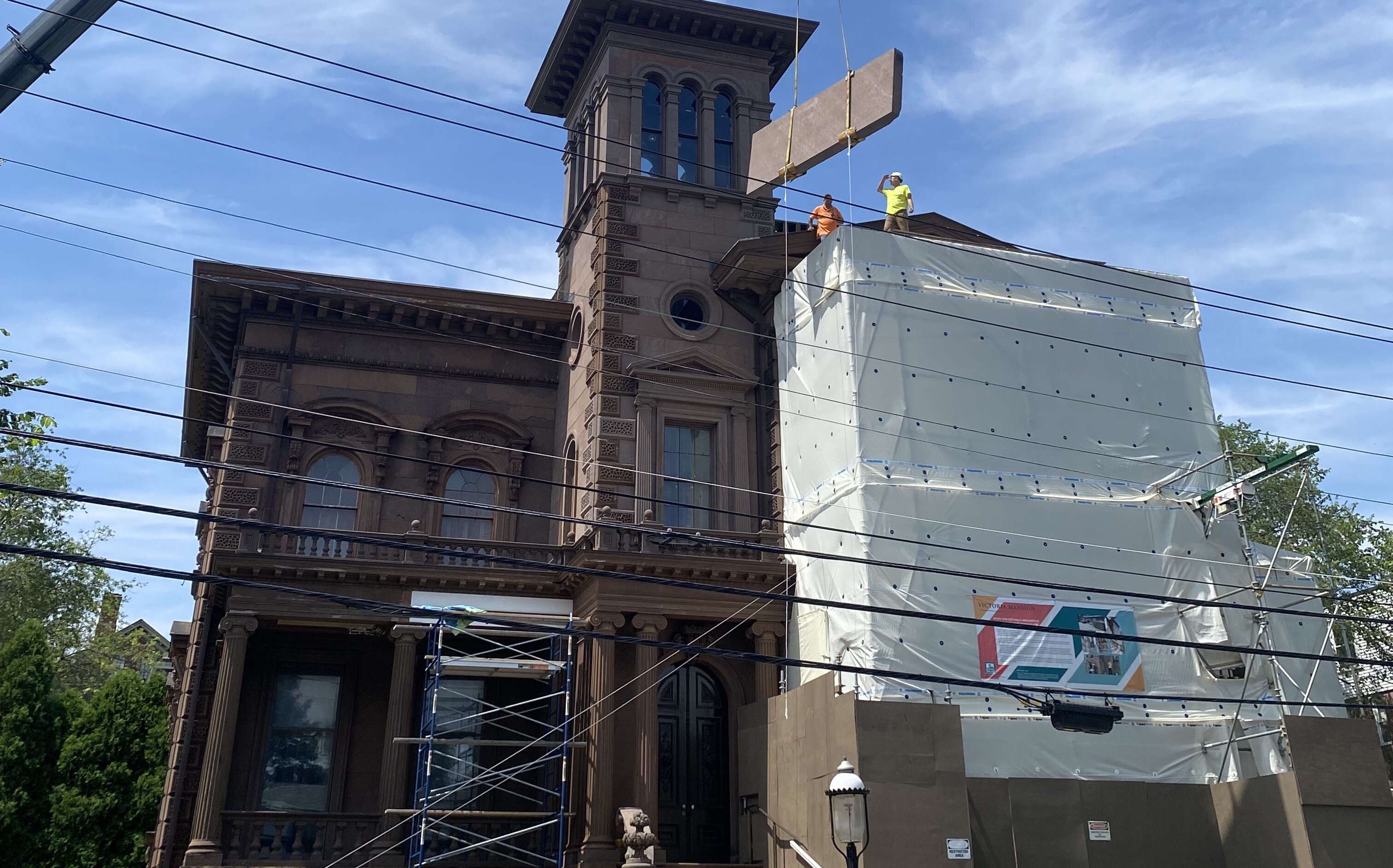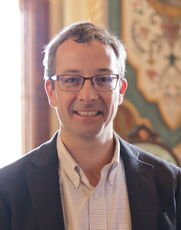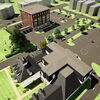
$8M preservation underway on Portland's Victoria Mansion
 Photo / Courtesy Victoria Mansion
Conservators work to preserve trompe l’oeil decorative paintings in the central stair hall.
Photo / Courtesy Victoria Mansion
Conservators work to preserve trompe l’oeil decorative paintings in the central stair hall.
A capital campaign launched by the nonprofit that owns Victoria Mansion in Portland is more than halfway toward its goal to raise $8 million toward preservation projects and public programs.
Victoria Mansion, a historic landmark at 109 Danforth St., dates back to 1860 and became a museum in the 1940s.
“This building is remarkably intact for a building of this period,” Timothy Brosnihan, Victoria Mansion’s executive director, told Mainebiz.

In May, the Victoria launched the public phase of its five-year, $8 million capital campaign.
A single bequest from the estate of Peter L. Sheldon Jr. raised half the sum right out of the gate and allowed some of the centerpiece projects to proceed before the public phase launched. The nonprofit’s board of directors and other supporters donated an additional $1 million as a challenge match.
Historic landmark
The mansion was built by Ruggles Sylvester Morse, who was born in Leeds in Androscoggin County, made his fortune in New Orleans as an owner of luxury hotels. In 1856, he bought two lots at the corner of Danforth and Park streets in Portland, with the intention of building a summer house in his home state.
New England architect Henry Austin designed the building in the Italianate style. Gustave Herter, founder of Herter Brothers of New York, designed the interior and its lavish furnishings.
At the time the Victoria Mansion was named a National Historic Landmark, in 1971, the building was in trouble. The roof leaked, the roofline woodwork was in an advanced state of deterioration and several projecting brownstone structures were on the verge of collapse.
From the early 1970s through the early 2000s, the museum addressed structural issues and sealed the weather envelope to protect the interiors.

Since 2012, major interior restorations have been completed. In 2022, the museum began its most ambitious paint conservation project — a two-year effort to clean and restore a soaring central stair hall.
The assemblage of furniture, window cornices and mirror and picture frames is the largest collection of objects from Herter’s workshop in the U.S. It includes figured maple and rosewood cabinetry with carved, incised, painted and inlaid ornament. There are carved winged female figures, floral oil paintings, rococo-style marquetry panels and 550 original pieces of textile, such as floral festoons made of fine silk wrapped around a delicate wire coil shaped into elaborate flowers and leaves.
Victoria Mansion has over 90% of the objects that were in the house in 1860 and strives to return the interiors to their original 1860 condition.
The nonprofit that owns Victoria Mansion goes by the same name.
Brownstone, trompe l’oeil
The two centerpiece projects involve restoring a large exterior window bay and preserving original decorative paintings on the walls and ceilings of the building’s three floors.
“The front bay project has been 10 years in the planning,” said Brosnihan.

The job involves restoring a 25-foot-high bay window and surrounding masonry, in kind with the original brownstone that came from Portland, Conn.
“It was in pretty tough shape,” he said.
Portland brownstone is a sandstone and over the building’s 165 years, it developed issues such as delamination.
“This structure had beautiful carved capital sand other details, that had all eroded away,” he said.
The work started in earnest last October to install in-kind stone and restore the eroded details. The project could wrap up this fall.
Interior work includes preservation of trompe l’oeil decorative paintings by Giuseppe Guidicini, an Italian artist who moved to the U.S. The paintings, throughout the house, are among his last surviving works.
Work has been underway for several years now to restore the artwork. In the central stair hall, which soars 40 foot tall up to a stained glass skylight, conservators are working on the second-story level at the moment.
“This is perhaps the largest and most challenging space to work in,” Brosnihan said.
The artwork conservation is expected to go another couple of years.
Before the current capital campaign, funds for the projects came from community donors, private foundations and a federal grant program. The federal program has since been cut.
“Our thinking about the role federal funding will play in fundraising has changed,” he said. “We might have to rely more on the community to backfill what might have been possible in the past.”
Contractors include Bay Project Contracting, of Waltham, Mass.; Ivan Myjer, Building & Monument Conservation, Portland, Conn.; Stone & Lime, North Brookfield, Mass.; John Wathne, Structures North Consulting Engineers Inc., Salem, Mass.; Granite Importers, Barre, Vt.; and Gianfranco Pocobene and Corrine Long with Gianfranco Pocobene Studio Inc., Malden, Mass.
Preservation, outreach
Goals over the next five years include placing educational, curatorial and outreach efforts on a solid foundation for the future.

The campaign’s honorary chair is Maine State Historian Earl Shettleworth Jr.
The campaign designates:
- $3.3 million to maintain and preserve the architecture and return the building to its 1860 appearance.
- $1.2 million to preserve the interior, with projects to conserve painted decoration and restore textiles and carpets.
- $1 million to expand educational staffing to amplify our engagement with schools across Maine and support a more robust program of historical research, partnering with institutions of higher education; and to provide hands-on training for the next generation of historic preservation tradespeople.
- $2.5 million to expand staff and infrastructure for offices and museum functions.
The hands-on preservation training began two years ago as a pilot project with two 2-week intensive classes so far, each with five students, for people who already work in the building trades and want to learn historic preservation. The program pays a stipend; students have been from Greater Portland.

“We’re looking to fund that sustainably,” Brosnihan said. “We want to keep it going and ramp it up.”
Annual visitation
The museum has several visiting seasons. From May through October, it offers guided tours to everyone from local visitors to vacationers and cruise ship passengers. The holiday season after Thanksgiving through the first week of January brings in local designers to decorate the house and draws local return visitors.
“It’s become a tradition for a lot of families,” said Brosnihan.
School groups flock to the museum from late January through April. The museum supplements the visits through an education program in the classroom.
All together, the museum gets just north of 30,000 visitors annually. It has four full-time staffers and about a dozen year-round part-time. About 100 volunteers and staff docents are on hand for house tours.
“People tend to think of historic house museums as static,” he said. “But we have quite a lot of work going on inside and out.”









0 Comments